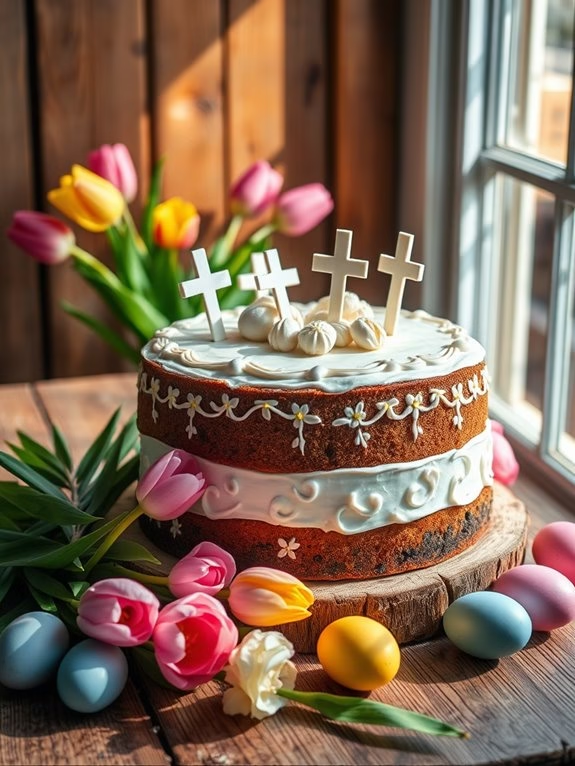Every Easter, I find myself irresistibly drawn to the kitchen, inspired to bake cakes that celebrate the beautiful traditions from around the world.
From slicing into a fragrant Italian Colomba Di Pasqua with its almond glaze to enjoying the sweet, braided Greek Tsoureki with hints of orange zest, each cake is a delicious tribute to a rich cultural heritage.
These recipes aren’t just about flavors; they carry symbols and stories, whether it’s the tender lamb-shaped cakes or the intricately decorated Russian Kulich.
Are you ready to uncover the secrets of these cherished recipes?
Let’s bring the essence of Easter to life through baking.

Italian Colomba Di Pasqua
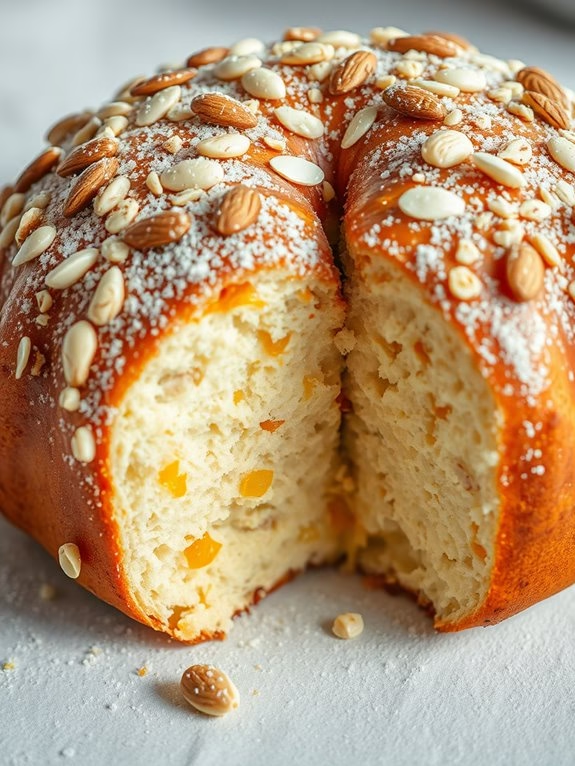
Italian Colomba Di Pasqua, or the Italian Easter Dove Cake, is a traditional sweet bread enjoyed during the Easter festivities. Its name, “Colomba,” means “dove” in Italian, and the cake is typically shaped like a dove to symbolize peace and renewal.
This delightful cake is similar to the Christmas Panettone, with its rich, fluffy texture and infusion of citrus and almonds. Its preparation involves a bit of time and patience due to the multiple rising periods required for the dough, but the end result is a beautifully aromatic and flavorful cake that captures the essence of Italian Easter celebrations.
The Colomba Di Pasqua’s unique flavor comes from a combination of candied orange peels, almonds, and a hint of vanilla, which blend harmoniously in the soft, buttery dough. The cake is topped with a sweet, crunchy almond glaze that contrasts beautifully with the tender crumb beneath.
Whether shared with family during Easter brunch or given as a gift, this cake is sure to impress with its authentic taste and elegant presentation.
Ingredients (Serves 4-6):
- 500g all-purpose flour
- 100g granulated sugar
- 150g unsalted butter, softened
- 3 eggs
- 1 egg yolk
- 25g fresh yeast or 7g active dry yeast
- 120ml warm milk
- 1 teaspoon vanilla extract
- Zest of 1 orange
- 100g candied orange peels
- 50g almonds, chopped
- 1/4 teaspoon salt
- 50g pearl sugar
- 50g whole almonds
Cooking Instructions:
- Prepare the Yeast Mixture: Dissolve the fresh yeast in warm milk and let it sit for about 10 minutes until it becomes frothy. If using dry yeast, mix it with a teaspoon of sugar before adding it to the milk.
- Make the Dough: In a large mixing bowl, combine the flour, granulated sugar, and salt. Create a well in the center and add the yeast mixture, eggs, egg yolk, and vanilla extract. Mix until the dough starts to come together.
- Knead the Dough: Add the softened butter to the dough and knead it on a lightly floured surface for about 10 minutes until it becomes smooth and elastic. Gradually incorporate the orange zest and candied orange peels during the kneading process.
- First Rise: Place the dough in a lightly greased bowl, cover it with a clean kitchen towel, and let it rise in a warm place for 2 hours or until doubled in size.
- Shape the Dough: Punch down the risen dough and shape it into a dove form using a traditional Colomba mold or freehand on a baking tray lined with parchment paper.
- Second Rise: Cover the shaped dough with a kitchen towel and let it rise again for 1 hour.
- Prepare the Topping: Preheat your oven to 180°C (350°F). In a small bowl, mix the chopped almonds with pearl sugar. Gently brush the top of the risen dough with a little water and sprinkle the almond-sugar mixture evenly over it. Press whole almonds into the dough.
- Bake the Cake: Place the cake in the preheated oven and bake for 35-40 minutes, or until it’s golden brown and a skewer inserted into the center comes out clean. If it browns too quickly, cover it loosely with aluminum foil.
- Cool the Cake: Allow the Colomba Di Pasqua to cool completely on a wire rack before serving.
Extra Tips:
For best results, verify all ingredients are at room temperature before starting. If the dough seems too sticky during kneading, add a little more flour, but be cautious to keep the dough soft.
Colomba molds are available in specialty stores or online, but if unavailable, shaping the dough by hand will still yield a delightful result. To enhance the flavor, consider soaking the candied orange peels in a little orange liqueur before adding them to the dough.
Enjoy this Italian tradition with a cup of coffee or tea for a truly festive Easter treat!
Greek Tsoureki Bread
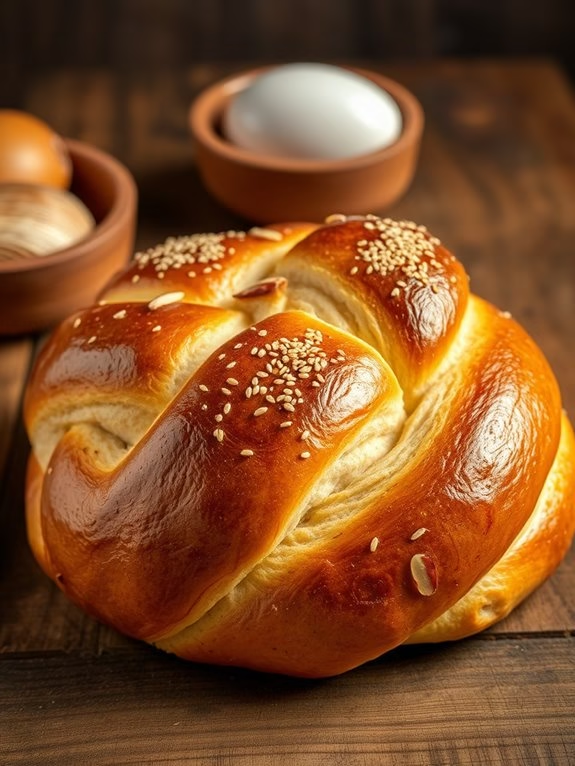
Greek Tsoureki Bread
Greek Tsoureki Bread is a traditional Easter bread that’s both delicious and visually stunning. This sweet, braided bread is typically flavored with unique ingredients such as mahleb and mastic, which give it a distinct taste that sets it apart from other types of sweet breads. The bread’s texture is soft and slightly chewy, making it a delightful accompaniment to your Easter festivities.
Whether served on its own or with a spread of jam or butter, Greek Tsoureki is sure to be a hit at your Easter table.
Making Greek Tsoureki Bread involves a few steps, but the result is well worth the effort. The process begins with creating a rich and flavorful dough that’s left to rise until it doubles in size. Once risen, the dough is divided, braided, and baked to golden perfection. The aroma of the bread as it bakes is irresistible, filling your home with the warm, sweet scent of Easter.
Perfect for a serving size of 4-6 people, this bread is a wonderful way to celebrate the holiday with friends and family.
Ingredients (for 4-6 servings):
- 4 cups all-purpose flour
- 1 cup milk
- 1/2 cup unsalted butter
- 3/4 cup granulated sugar
- 3 large eggs
- 1 packet (2 1/4 tsp) active dry yeast
- 1/2 teaspoon salt
- 1 teaspoon mahleb, ground
- 1/4 teaspoon mastic, ground
- 1 tablespoon orange zest
- 1 egg yolk (for egg wash)
- 1 tablespoon water (for egg wash)
- Sliced almonds (optional, for topping)
- Sesame seeds (optional, for topping)
Cooking Instructions:
- Activate the Yeast: In a small bowl, warm the milk to about 110°F (43°C). Stir in the yeast and a teaspoon of sugar, then let it sit for about 10 minutes until it becomes frothy.
- Prepare the Dough: In a large mixing bowl, combine the flour, sugar, salt, mahleb, mastic, and orange zest. In a separate bowl, beat the eggs, then add them to the dry ingredients along with the yeast mixture. Melt the butter and mix it into the dough until all ingredients are well incorporated.
- Knead the Dough: Knead the dough on a lightly floured surface for about 10 minutes until it’s smooth and elastic. You can also use a stand mixer with a dough hook attachment for this step.
- First Rise: Place the kneaded dough in a greased bowl, cover it with a clean cloth or plastic wrap, and let it rise in a warm place for about 1 to 2 hours or until it doubles in size.
- Shape the Bread: Once risen, punch down the dough to release any air. Divide it into three equal portions, roll each portion into a long rope, and braid them together. Tuck the ends underneath to secure the braid.
- Second Rise: Place the braided dough on a baking sheet lined with parchment paper. Cover it lightly with a cloth and let it rise again for about 45 minutes.
- Prepare for Baking: Preheat your oven to 350°F (175°C). In a small bowl, mix the egg yolk with water to create an egg wash. Brush the egg wash over the risen braid and sprinkle with sliced almonds or sesame seeds if desired.
- Bake the Bread: Bake in the preheated oven for about 30-35 minutes or until the bread is golden brown and sounds hollow when tapped on the bottom.
- Cool and Serve: Allow the bread to cool on a wire rack before slicing. Serve warm or at room temperature.
Extra Tips:
When making Greek Tsoureki Bread, it’s essential to verify that your yeast is active and frothy before proceeding with the recipe, as this will help the dough rise correctly.
The dough can be a bit sticky due to the eggs and butter, so don’t hesitate to lightly flour your hands and work surface while kneading. If you can’t find mahleb or mastic, you can substitute them with vanilla extract or omit them, but keep in mind that these spices are what give Tsoureki its unique flavor.
Finally, for a shinier finish, make sure you brush the egg wash evenly over the entire surface of the bread.
Russian Kulich Cake
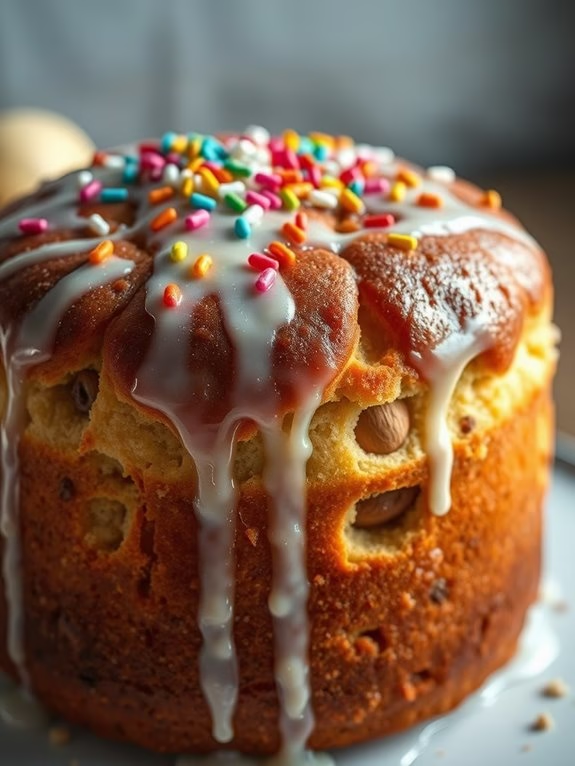
Russian Kulich Cake is a traditional Easter bread that’s often enjoyed in Russian households during the holiday season. This tall, cylindrical cake is known for its sweet, rich flavor and is typically adorned with a simple sugar glaze and colorful sprinkles. Kulich isn’t only a delight to the taste buds but also a feast for the eyes with its majestic height and vibrant decoration. The cake is often paired with Paskha, a sweetened cheese spread, making it a delightful Easter treat.
The preparation of Kulich is a labor of love, requiring time and patience to achieve the perfect texture and flavor. The dough is enriched with butter, eggs, and often flavored with vanilla or citrus zest, giving the cake its characteristic richness and aroma. Traditionally, the cake is baked in tall, cylindrical tins or even clean coffee cans to give it its distinctive shape. Once baked, it’s glazed and decorated, making it a centerpiece on Easter tables.
Ingredients for Russian Kulich Cake (serves 4-6):
- 1 cup whole milk
- 1/2 cup unsalted butter
- 1 cup granulated sugar
- 1 teaspoon salt
- 1 tablespoon active dry yeast
- 4 cups all-purpose flour
- 4 large eggs
- 1 teaspoon vanilla extract
- 1 tablespoon lemon zest
- 1/2 cup golden raisins
- 1/2 cup chopped almonds
- 1/2 cup candied fruit peel
- 1 cup confectioners’ sugar
- 2 tablespoons lemon juice
- Colored sprinkles for decoration
Cooking Instructions:
- Prepare the Milk Mixture: In a small saucepan, heat the milk over low heat until it’s just warm. Remove from heat and add the butter, stirring until it melts. Stir in the sugar and salt until dissolved. Allow the mixture to cool until lukewarm.
- Activate the Yeast: In a large bowl, dissolve the active dry yeast in 1/4 cup of warm water. Let it sit for about 5-10 minutes until it becomes frothy, indicating that the yeast is active.
- Mix the Dough: Add the lukewarm milk mixture to the yeast. Beat in the eggs, one at a time, followed by the vanilla extract and lemon zest. Gradually add the flour, mixing until a dough forms. Knead the dough on a floured surface for about 10 minutes until it’s smooth and elastic.
- Incorporate the Add-ins: Gently knead in the raisins, almonds, and candied fruit peel until evenly distributed throughout the dough.
- First Rise: Place the dough in a greased bowl, cover it with a damp cloth, and let it rise in a warm place until doubled in size, approximately 1-2 hours.
- Prepare the Baking Tins: Grease two tall cylindrical baking tins or coffee cans. Preheat the oven to 350°F (175°C).
- Second Rise: Punch down the risen dough and divide it between the prepared tins. Cover again and let rise until the dough reaches the top of the tins, about 30 minutes.
- Bake the Kulich: Bake in the preheated oven for about 35-40 minutes, or until the tops are golden and a skewer inserted into the center comes out clean. Allow them to cool in the tins for 10 minutes before transferring to a wire rack to cool completely.
- Prepare the Glaze: In a small bowl, mix the confectioners’ sugar with the lemon juice until smooth. Drizzle the glaze over the cooled cakes, letting it run down the sides.
- Decorate: Sprinkle the glazed Kulich with colored sprinkles before the glaze sets.
Extra Tips:
When making Russian Kulich Cake, make sure that all ingredients are at room temperature, especially the eggs and butter, to help the dough rise properly.
Be patient during the rising process; if the dough doesn’t double in size, give it more time. If you find the top of the Kulich browning too quickly in the oven, cover it loosely with aluminum foil to prevent burning.
For an additional flavor boost, you can soak the raisins in rum or orange juice before adding them to the dough. Enjoy your Kulich with a cup of tea or coffee to celebrate Easter in true Russian style.
Polish Babka Wielkanocna

Polish Babka Wielkanocna
Polish Babka Wielkanocna is a traditional Easter cake that holds a special place in Polish culture. Known for its rich, buttery taste and light, fluffy texture, this cake is often enjoyed during Easter celebrations. Its distinct shape, usually created using a Bundt or fluted pan, adds a festive touch to any Easter table.
The cake is often flavored with hints of vanilla or citrus and sometimes drizzled with a simple glaze or sprinkled with powdered sugar, making it an irresistible treat for both young and old.
The origins of Babka Wielkanocna can be traced back to the early days of Polish culinary history, where it was traditionally made with ingredients that symbolize prosperity and abundance. Over the years, this timeless dessert has evolved, with numerous family recipes passing down through generations.
Despite its humble beginnings, Babka Wielkanocna remains a beloved and cherished part of Easter festivities in Poland and beyond. To make this delightful cake for your Easter celebration with a serving size of 4-6 people, follow the recipe below.
Ingredients:
- 3 1/2 cups all-purpose flour
- 1 cup sugar
- 1 cup unsalted butter, softened
- 4 large eggs
- 1 cup whole milk
- 2 1/4 teaspoons active dry yeast
- 1 teaspoon vanilla extract
- Zest of 1 lemon
- 1/2 teaspoon salt
- 1/2 cup raisins (optional)
- Powdered sugar for dusting or glaze (optional)
Instructions:
- Prepare the Yeast Mixture: In a small bowl, warm the milk until it’s lukewarm (about 110°F/43°C). Add the yeast and a teaspoon of sugar, stirring gently. Let this mixture sit for about 10 minutes until it becomes frothy, indicating that the yeast is active.
- Cream Butter and Sugar: In a large mixing bowl, cream together the softened butter and the remaining sugar until light and fluffy. This process can take about 3-5 minutes with an electric mixer set to medium speed.
- Incorporate Eggs and Flavorings: Add the eggs one at a time to the butter and sugar mixture, beating well after each addition. Stir in the vanilla extract and lemon zest until well combined.
- Combine Dry Ingredients: In a separate bowl, whisk together the flour and salt. Gradually add the flour mixture to the egg mixture, alternating with the yeast mixture, beginning and ending with the flour. Mix until just combined.
- Add Optional Ingredients: If using raisins, fold them into the batter gently with a spatula, making sure of even distribution throughout the mixture.
- First Rise: Transfer the batter to a lightly greased Bundt or fluted cake pan. Cover with a clean kitchen towel and let it rise in a warm place for about 1-2 hours, or until it has doubled in size.
- Preheat Oven and Bake: Preheat your oven to 350°F (175°C). Once the dough has risen, place the pan in the preheated oven and bake for 30-40 minutes, or until a toothpick inserted into the center comes out clean.
- Cool and Serve: Allow the cake to cool in the pan for about 10 minutes. Then, carefully invert it onto a wire rack to cool completely. Dust with powdered sugar or drizzle with glaze before serving, if desired.
Extra Tips:
For the best results, make certain that all ingredients are at room temperature before starting the recipe. This helps in achieving a smooth batter and even texture.
Be patient with the rising process; a warm, draft-free environment allows the dough to rise adequately. If you prefer a more citrusy flavor, you can add orange zest along with the lemon zest.
Finally, storing the cake in an airtight container helps maintain its freshness for a few days, making it a perfect make-ahead dessert for your Easter celebration.
Spanish Mona De Pascua

Spanish Mona De Pascua is a traditional Easter cake that’s especially popular in Catalonia, Valencia, and other regions of Spain. This delightful cake is typically enjoyed on Easter Monday as a symbol of the end of Lent and is often gifted by godparents to their godchildren.
The Mona de Pascua is characterized by its rich and buttery dough, often flavored with lemon or orange zest, and decorated with colorful eggs or chocolate figurines. This cake not only serves as a delicious treat but also as a beautiful centerpiece for the Easter table.
The origins of Mona de Pascua date back several centuries and have evolved with different variations across Spanish regions. The traditional version of the cake is a sweet bread that resembles a brioche, adorned with hard-boiled eggs or chocolate eggs, while modern interpretations often include a variety of toppings such as candied fruits, almonds, and sweet glazes.
Preparing this cake is a delightful way to celebrate Easter with family and friends, creating memories and sharing the joy of the holiday.
Ingredients for 4-6 servings:
- 500g all-purpose flour
- 100g sugar
- 100g unsalted butter, softened
- 3 large eggs
- 200ml milk
- 25g fresh yeast or 8g active dry yeast
- Zest of 1 lemon or orange
- 1 teaspoon vanilla extract
- 1/4 teaspoon salt
- Hard-boiled eggs or chocolate eggs for decoration
- 50g sliced almonds (optional)
- Sugar crystals or sprinkles for decoration (optional)
Instructions:
- Prepare the Yeast Mixture: In a small bowl, dissolve the fresh yeast or active dry yeast in lukewarm milk. Add a teaspoon of sugar and let it sit for about 10 minutes until it becomes frothy and bubbly.
- Make the Dough: In a large mixing bowl, combine the flour, remaining sugar, and salt. Make a well in the center and add the yeast mixture, softened butter, eggs, lemon or orange zest, and vanilla extract. Mix the ingredients together until a dough forms.
- Knead the Dough: Transfer the dough onto a floured surface and knead it for about 10 minutes until it’s smooth and elastic. If the dough is too sticky, add a little more flour as needed.
- First Rise: Place the kneaded dough in a lightly oiled bowl, cover it with a clean kitchen towel, and let it rise in a warm place for about 1.5 to 2 hours, or until it has doubled in size.
- Shape the Cake: Once the dough has risen, punch it down to release the air and knead it again briefly. Shape the dough into a round or oval loaf and place it on a baking tray lined with parchment paper. If you’re using hard-boiled eggs, gently press them into the top of the dough.
- Second Rise: Cover the shaped dough with a towel and let it rise again for about 30-45 minutes, until slightly puffed.
- Preheat the Oven: Preheat your oven to 180°C (350°F).
- Decorate and Bake: Brush the dough with a beaten egg to give it a shiny appearance. If desired, sprinkle sliced almonds and sugar crystals on top. Bake the cake in the preheated oven for 25-30 minutes, or until golden brown and cooked through.
- Cool and Serve: Allow the Mona de Pascua to cool on a wire rack before serving. Decorate with chocolate eggs or additional Easter-themed decorations if desired.
Extra Tips:
For an extra fragrant Mona de Pascua, consider adding a teaspoon of orange blossom water to the dough. If you’re using chocolate eggs for decoration, wait until the cake has cooled completely before placing them on top to prevent melting.
The dough can be prepared a day in advance and left to rise slowly in the refrigerator overnight, which can enhance the flavors. When shaping the cake, verify the eggs are securely nestled into the dough to avoid them falling off during baking.
German Osterlamm Cake
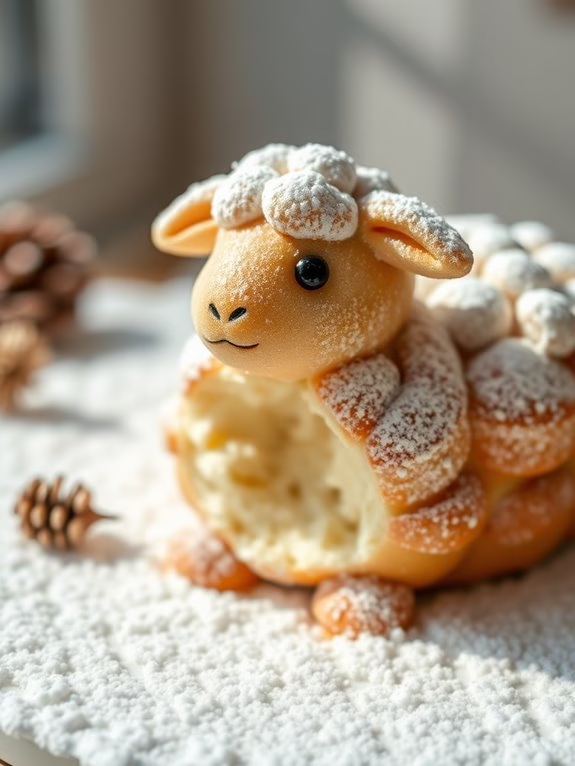
German Osterlamm Cake is a traditional Easter treat that’s both delicious and symbolic. This lamb-shaped cake is often baked in a special mold and served as a centerpiece during Easter celebrations in Germany. The cake isn’t only a delightful dessert but also carries a deeper meaning, symbolizing the Lamb of God.
Made with simple ingredients like flour, eggs, and sugar, the Osterlamm Cake is a demonstration to the beauty of simplicity in baking, with a light, fluffy texture and a subtle sweetness that makes it perfect for any Easter gathering.
The preparation of the Osterlamm Cake requires attention to detail, especially when it comes to achieving the perfect shape and texture. Traditionally, this cake is dusted with powdered sugar, giving it the appearance of a snowy white lamb. The process of making this cake is a joyful endeavor that brings families together, as they anticipate the festive season.
Whether you’re a seasoned baker or trying this recipe for the first time, the German Osterlamm Cake is a wonderful addition to your Easter menu.
Ingredients for 4-6 servings:
- 1 1/2 cups all-purpose flour
- 1 teaspoon baking powder
- 1/4 teaspoon salt
- 1/2 cup unsalted butter, softened
- 3/4 cup granulated sugar
- 3 large eggs
- 1 teaspoon vanilla extract
- 1/2 cup milk
- Powdered sugar, for dusting
- Butter and flour, for greasing and dusting the mold
Cooking Instructions:
- Preheat the Oven: Begin by preheating your oven to 350°F (175°C). This guarantees that the oven is at the right temperature when you’re ready to bake the cake.
- Prepare the Lamb Mold: Thoroughly grease the lamb-shaped cake mold with butter, making sure to cover all the details. Dust the mold with flour to prevent the cake from sticking. Tap out any excess flour.
- Mix Dry Ingredients: In a medium bowl, whisk together the all-purpose flour, baking powder, and salt. Set this mixture aside for later use.
- Cream Butter and Sugar: In a large mixing bowl, beat the softened butter and granulated sugar together using an electric mixer on medium speed until the mixture is light and fluffy. This should take about 3-5 minutes.
- Add Eggs and Vanilla: Add the eggs one at a time, beating well after each addition. Stir in the vanilla extract until fully incorporated.
- Combine Wet and Dry Ingredients: Gradually add the dry flour mixture to the butter and sugar mixture, alternating with the milk. Begin and end with the flour mixture. Mix until just combined, being careful not to overmix.
- Fill the Mold: Carefully pour the batter into the prepared lamb mold, guaranteeing that it fills all sections evenly. Smooth the top with a spatula.
- Bake the Cake: Place the mold in the preheated oven and bake for about 35-40 minutes, or until a toothpick inserted into the center comes out clean.
- Cool and Unmold: Allow the cake to cool in the mold for about 10 minutes. Carefully remove the cake from the mold and transfer it to a wire rack to cool completely.
- Dust with Powdered Sugar: Once the cake is fully cooled, dust it generously with powdered sugar to give it a festive, snowy appearance.
Extra Tips:
When making the German Osterlamm Cake, it’s essential to confirm that the mold is well-prepared to prevent the cake from sticking. If you don’t have a lamb-shaped mold, you can use a similar-sized alternative shape, though it won’t have the traditional look.
Additionally, make sure that all your ingredients are at room temperature before you start mixing, as this helps in achieving a smoother batter and more even baking. Finally, don’t rush the cooling process before dusting with powdered sugar, as the cake needs to be completely cool for the sugar to adhere properly without melting.
British Simnel Cake
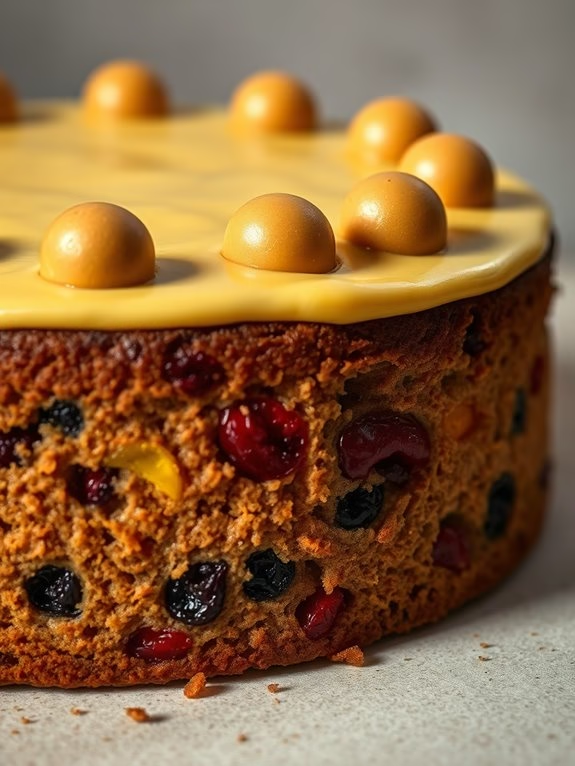
The British Simnel Cake is a traditional Easter treat, rich with history and flavor. This delicious, fruit-laden cake is distinguished by its use of marzipan, both baked into the middle and adorning the top, often formed into eleven balls to represent the apostles, minus Judas.
Historically, this cake was baked by daughters to present to their mothers on Mothering Sunday, which falls on the fourth Sunday of Lent. The Simnel Cake is a delightful way to celebrate the Easter season, combining the warmth of spices with the sweetness of dried fruits and the subtle almond flavor of marzipan.
Crafting a Simnel Cake involves a few stages, but the result is a moist, flavorful cake that pairs perfectly with a cup of tea. The key to a great Simnel Cake is the balance of flavors—the richness of butter, the sweet and tangy notes of the dried fruit, the aromatic spices, and the smooth, sweet marzipan.
This recipe serves 4-6 people and is ideal for an Easter gathering, providing a slice of traditional British baking to your festive table.
Ingredients:
- 225g plain flour
- 175g butter, softened
- 175g light muscovado sugar
- 3 large eggs
- 225g mixed dried fruit
- 100g glacé cherries, halved
- 50g chopped mixed peel
- Zest of 1 lemon
- 2 tsp mixed spice
- 1 tsp baking powder
- 450g marzipan
- 2 tbsp apricot jam
- 1-2 tbsp milk (if needed)
Cooking Instructions:
- Preheat and Prepare the Cake Tin: Preheat your oven to 140°C (284°F) for fan ovens or 160°C (320°F) for conventional ovens. Grease a 20cm (8-inch) round cake tin and line it with baking parchment.
- Mix the Cake Batter: In a large mixing bowl, cream the softened butter and muscovado sugar together until light and fluffy. Gradually add in the eggs, one at a time, beating well after each addition. If the mixture starts to curdle, add a tablespoon of the flour.
- Combine Dry Ingredients: Sift the flour, mixed spice, and baking powder into a separate bowl. Gradually fold the dry mixture into the creamed mixture. If the batter is too stiff, add a tablespoon or two of milk to achieve a dropping consistency.
- Incorporate Fruits and Zest: Add the mixed dried fruit, glacé cherries, mixed peel, and lemon zest to the cake batter. Gently fold them in until evenly distributed.
- Prepare the Marzipan Layer: Divide the marzipan into three portions. Roll out one portion into a 20cm circle. Spoon half of the cake mixture into the prepared tin, smoothing the surface. Place the rolled marzipan on top, then add the remaining cake mixture over this layer.
- Bake the Cake: Bake the cake for 2-2.5 hours, or until a skewer inserted into the center comes out clean. If the top of the cake is browning too quickly, cover it loosely with foil.
- Cool and Decorate: Allow the cake to cool in the tin for about 10 minutes, then turn it out onto a wire rack to cool completely. Roll out another portion of marzipan to the same size as before, and place it on top of the cooled cake. Brush the top of the cake with apricot jam to help the marzipan adhere.
- Create the Apostles: With the remaining marzipan, form eleven equal-sized balls and place them evenly around the edge of the cake. Use a little jam to stick them in place.
- Finish Under the Grill: Place the cake under a preheated grill for a few minutes until the marzipan is lightly browned. Watch carefully to prevent burning.
Extra Tips:
For the best flavor, soak the dried fruits in a little orange juice or brandy overnight before baking, which can add extra moisture and richness.
If you find marzipan too sweet, you can use a thinner layer or substitute with almond paste. It’s important to monitor the cake closely towards the end of the baking time, as ovens can vary and you don’t want it to dry out.
Finally, if you’re making this cake in advance, it can be stored in an airtight container for up to a week, allowing the flavors to mature beautifully.

Portuguese Folar Da Páscoa

Portuguese Folar Da Páscoa
Folar Da Páscoa is a traditional Portuguese Easter bread that’s as rich in flavor as it’s in cultural history. This savory bread is often baked during the Easter season and is traditionally associated with celebrations and family gatherings. The bread is mildly sweet and uniquely flavored with hints of spices like cinnamon and fennel seeds, and it’s often topped with hard-boiled eggs, symbolizing the rebirth and renewal associated with Easter.
The preparation of this delightful bread involves creating a yeast-based dough that’s enriched with butter and milk, which gives it a soft and tender crumb. The dough is then shaped, and hard-boiled eggs are nestled within, adding a festive touch. This recipe serves 4-6 people, making it an ideal centerpiece for a small Easter gathering or family meal.
Ingredients:
- 500g all-purpose flour
- 100g sugar
- 2 tsp ground cinnamon
- 1 tsp fennel seeds
- 1/2 tsp salt
- 10g active dry yeast
- 250ml warm milk
- 100g unsalted butter, melted
- 3 large eggs
- 3 hard-boiled eggs (for decoration)
- 1 egg yolk (for glazing)
Cooking Instructions:
- Prepare the Yeast Mixture: In a small bowl, dissolve the active dry yeast in warm milk and allow it to sit for about 10 minutes until it becomes frothy. This indicates that the yeast is activated and ready to use.
- Mix Dry Ingredients: In a large mixing bowl, combine the flour, sugar, ground cinnamon, fennel seeds, and salt. Stir the ingredients until they’re well blended.
- Combine Wet Ingredients: In a separate bowl, beat 2 eggs and add the melted butter. Mix well. Add the yeast mixture to this and stir until everything is well combined.
- Form the Dough: Make a well in the center of the dry ingredients and pour the wet mixture into it. Knead the mixture together until a dough forms. Continue kneading for approximately 10 minutes, until the dough is smooth and elastic.
- First Rise: Place the dough in a lightly oiled bowl, cover it with a damp cloth, and let it rise in a warm place for about 1.5 hours, or until it has doubled in size.
- Shape the Bread: Punch down the dough and divide it into two equal parts. Roll each part into a rope. Twist the ropes together and form a circle, pinching the ends to seal. Nestle the hard-boiled eggs into the dough, spacing them evenly around the circle.
- Second Rise: Place the shaped bread on a baking tray lined with parchment paper. Cover it with a damp cloth and let it rise for another 30 minutes.
- Preheat and Glaze: Preheat your oven to 180°C (350°F). Beat the remaining egg yolk and lightly brush it over the surface of the bread for a glossy finish.
- Bake: Place the bread in the preheated oven and bake for 25-30 minutes, or until it’s golden brown and cooked through. Allow the bread to cool on a wire rack before serving.
Extra Tips:
For a more aromatic bread, you can toast the fennel seeds lightly before adding them to the dry ingredients. This will enhance their flavor and add an extra layer of complexity to the bread.
Additionally, if you prefer a sweeter bread, you can increase the sugar by an extra 25g. Make sure to check the bread during the last few minutes of baking to prevent overbaking. If the top darkens too quickly, cover it loosely with aluminum foil.
Enjoy your Folar Da Páscoa warm or at room temperature for the best taste experience.
French Gâteau De Pâques
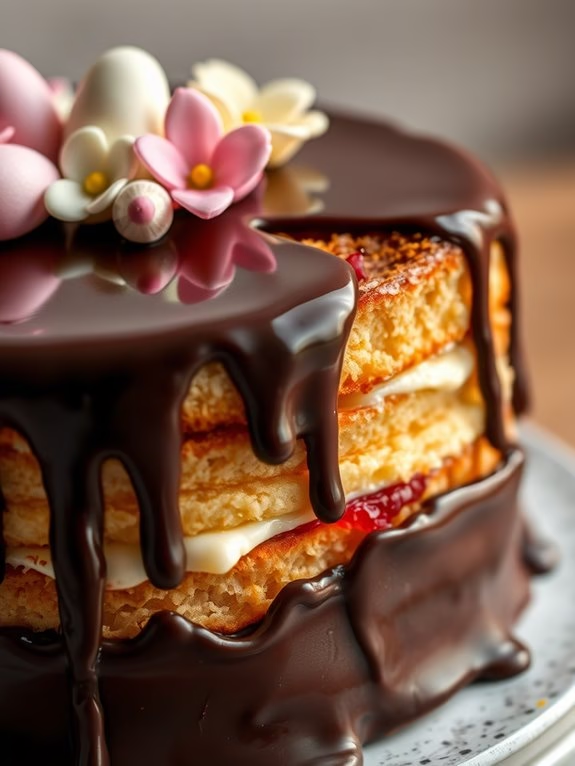
French Gâteau De Pâques, or Easter cake, is a delightful and elegant dessert that captures the essence of the holiday with its rich flavors and beautiful presentation. This traditional French cake is typically composed of layers of light sponge cake, filled with a luscious pastry cream or fruit jam, and topped with a decadent chocolate glaze.
Decorated with pastel-colored candies or springtime flowers, the Gâteau De Pâques isn’t only a treat for the taste buds but also a feast for the eyes, making it a perfect centerpiece for your Easter celebration.
The origins of Gâteau De Pâques can be traced back to French patisserie traditions, where it has been a beloved staple during the Easter season. This cake embodies the joy and renewal that Easter represents, with its vibrant colors and rich flavors.
Whether you’re hosting a family gathering or enjoying a quiet Easter brunch, this cake is sure to impress with its classic French elegance and irresistible taste. Prepare to indulge in the artistry of French baking with this delightful recipe that serves 4-6 people.
Ingredients
- 1 cup all-purpose flour
- 1 cup granulated sugar
- 4 large eggs
- 1 teaspoon vanilla extract
- 1/2 teaspoon baking powder
- 1/4 teaspoon salt
- 1/2 cup unsalted butter, melted
- 1 cup heavy cream
- 1/2 cup pastry cream or fruit jam
- 1 cup dark chocolate, melted
- Assorted pastel-colored candies or edible flowers for decoration
Instructions
- Preheat and Prepare: Preheat your oven to 350°F (175°C). Grease and flour a 9-inch round cake pan, making certain all sides are evenly coated to prevent sticking.
- Mix Dry Ingredients: In a medium bowl, sift together the flour, baking powder, and salt. Set aside.
- Whip Eggs and Sugar: In a large mixing bowl, beat the eggs and sugar with an electric mixer on high speed until the mixture is pale and thick, about 5 minutes. This step is vital for incorporating air, which will give the cake its light and fluffy texture.
- Combine Ingredients: Gently fold in the vanilla extract and dry ingredients into the egg mixture, taking care not to deflate the eggs. Gradually add the melted butter, folding until the batter is smooth and well combined.
- Bake the Cake: Pour the batter into the prepared cake pan and smooth the top with a spatula. Bake for 25-30 minutes or until a toothpick inserted into the center comes out clean. Allow the cake to cool in the pan for 10 minutes before transferring it to a wire rack to cool completely.
- Prepare the Filling: Whip the heavy cream in a separate bowl until soft peaks form. If using pastry cream as a filling, gently fold it into the whipped cream until combined.
- Assemble the Cake: Once the cake is completely cool, slice it horizontally into two even layers. Spread the pastry cream or fruit jam mixture evenly over the bottom layer, then place the top layer back on.
- Apply Chocolate Glaze: Pour the melted dark chocolate over the top of the assembled cake, allowing it to drip slightly over the sides for a decorative effect.
- Decorate: Garnish the top of the cake with pastel-colored candies or edible flowers, arranging them in a circular pattern for a festive Easter appearance.
Extra Tips
When making the Gâteau De Pâques, guarantee your cake layers are completely cool before adding the filling to prevent the cream from melting.
If you’re short on time, the sponge cake can be baked a day in advance and stored in an airtight container. For a different flavor profile, consider using a fruit jam that complements the richness of the chocolate, such as raspberry or apricot.
Finally, when decorating, less is often more; a few well-placed decorations can make the cake look elegant and sophisticated.
Swedish Påsktårta
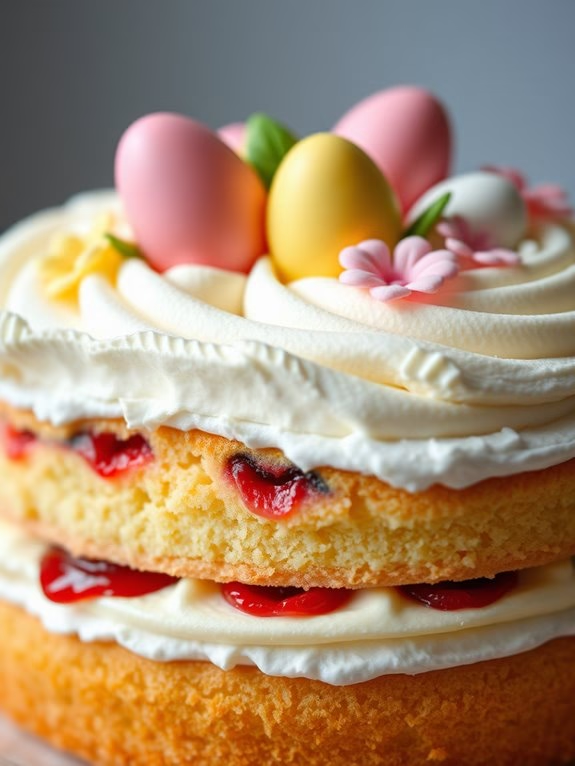
Swedish Påsktårta is a delightful and festive cake traditionally enjoyed during Easter celebrations in Sweden. This cake, characterized by its vibrant colors and rich flavors, is a feast for both the eyes and the palate. The layers of sponge cake are often filled with a luscious vanilla custard and sweet raspberry jam, then adorned with whipped cream and marzipan decorations, typically fashioned in the form of colorful spring flowers or Easter eggs.
Making this cake is a rewarding process that combines classic baking techniques with creative decorating skills, resulting in a centerpiece dessert that’s sure to impress your guests.
The beauty of Swedish Påsktårta lies in its balance of textures and flavors. The light and fluffy sponge cake layers provide a perfect canvas for the smooth and creamy custard, while the tangy raspberry jam adds a revitalizing contrast. The marzipan, used both for decoration and as a topping, adds a sweet almond flavor that complements the other elements of the cake.
Whether you’re sharing it with family or serving it at an Easter gathering, this cake is a delicious way to celebrate the season‘s traditions and the joys of spring.
Ingredients (for 4-6 servings)
- 4 large eggs
- 1 cup granulated sugar
- 1 cup all-purpose flour
- 1 teaspoon baking powder
- 1/4 cup milk
- 1 teaspoon vanilla extract
- 1 cup heavy cream
- 1 tablespoon confectioners’ sugar
- 1/2 cup raspberry jam
- 1 cup vanilla custard
- 8 oz marzipan
- Food coloring (optional)
Instructions
- Preheat and Prepare: Preheat your oven to 350°F (175°C). Grease and flour two 8-inch round cake pans to prevent the cakes from sticking.
- Make the Sponge Cake: In a large mixing bowl, whisk together the eggs and granulated sugar until the mixture is pale and fluffy. In a separate bowl, sift together the flour and baking powder. Gradually fold the dry ingredients into the egg mixture. Add the milk and vanilla extract, mixing gently until just combined. Divide the batter evenly between the prepared cake pans.
- Bake the Cakes: Place the cake pans in the preheated oven and bake for about 20-25 minutes, or until a toothpick inserted into the center comes out clean. Allow the cakes to cool in the pans for 10 minutes before turning them out onto a wire rack to cool completely.
- Prepare the Filling: While the cakes are cooling, whip the heavy cream with the confectioners’ sugar until stiff peaks form. Set aside for assembling the cake.
- Assemble the Cake: Once the cakes are completely cool, place one layer on a serving plate. Spread a layer of raspberry jam across the top, followed by a generous layer of vanilla custard. Place the second cake layer on top.
- Decorate: Spread the whipped cream evenly over the top and sides of the cake. Roll out the marzipan and use food coloring if desired to create colored decorations, such as flowers or Easter eggs, and arrange them on the cake.
- Chill and Serve: Chill the cake in the refrigerator for at least 30 minutes before serving to allow the flavors to meld and the decorations to set.
Extra Tips
For the best results, make sure your eggs are at room temperature before starting the cake, as this will help achieve maximum volume when whisking.
If you want to add a touch of sophistication, consider flavoring your whipped cream with a splash of almond or lemon extract. When decorating with marzipan, dust your work surface with a little confectioners’ sugar to prevent sticking.
Finally, for a truly festive look, use edible gold dust or glitter to add a shimmering finish to your marzipan decorations.
Finnish Pääsiäiskakku
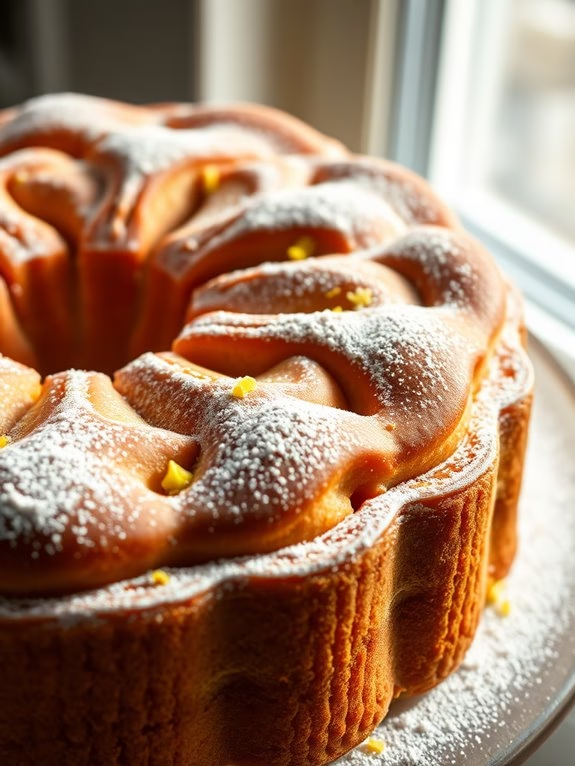
Finnish Pääsiäiskakku****
Pääsiäiskakku, also known as Finnish Easter Cake, is a delightful treat that captures the essence of Finnish Easter celebrations. This cake is a harmonious blend of gentle spices and rich flavors, often characterized by its moist texture and a subtle hint of citrus. Traditionally baked during the Easter season, Pääsiäiskakku offers a comforting sweetness that pairs beautifully with a cup of coffee or tea, making it a perfect centerpiece for any festive gathering.
The cake’s origins are deeply rooted in Finnish culture, where baking is a cherished tradition. The use of cardamom, a popular spice in Finnish baking, adds a unique flavor that distinguishes this cake from other Easter confections. This recipe results in a cake that’s both simple to prepare and impressive in its taste and presentation, making it a favorite choice for anyone looking to explore international Easter recipes. The following instructions will guide you in creating a Pääsiäiskakku that serves 4-6 people.
Ingredients:
- 1 cup (225g) unsalted butter, softened
- 1 cup (200g) granulated sugar
- 3 large eggs
- 1 teaspoon vanilla extract
- 2 cups (250g) all-purpose flour
- 1 teaspoon baking powder
- 1/2 teaspoon ground cardamom
- 1/4 teaspoon salt
- 1/2 cup (120ml) whole milk
- Zest of 1 lemon
- 1/4 cup (60ml) lemon juice
- Powdered sugar, for dusting
Cooking Instructions:
- Preheat the Oven: Begin by preheating your oven to 350°F (175°C). Grease a 9-inch round cake pan or line it with parchment paper to prevent sticking.
- Cream the Butter and Sugar: In a large mixing bowl, beat the softened butter and granulated sugar together using an electric mixer until light and fluffy. This should take about 3-4 minutes.
- Add Eggs and Vanilla: Add the eggs one at a time, beating well after each addition. Stir in the vanilla extract until fully incorporated.
- Mix Dry Ingredients: In a separate bowl, sift together the flour, baking powder, ground cardamom, and salt to guarantee even distribution of the leavening agents.
- Combine Wet and Dry Ingredients: Gradually add the dry ingredients to the creamed mixture, alternating with the milk. Start and end with the dry ingredients. Mix until just combined.
- Add Lemon Flavors: Gently fold in the lemon zest and lemon juice. Mix until the zest and juice are evenly distributed throughout the batter.
- Bake the Cake: Pour the batter into the prepared cake pan and smooth the top with a spatula. Bake in the preheated oven for 40-45 minutes, or until a toothpick inserted into the center comes out clean.
- Cool and Serve: Allow the cake to cool in the pan for about 10 minutes before transferring it to a wire rack to cool completely. Once cooled, dust the top with powdered sugar before serving.
Extra Tips:
To enhance the flavor of your Pääsiäiskakku, consider using freshly ground cardamom for a more intense aroma and taste. Ascertain all your ingredients, especially the butter and eggs, are at room temperature before you start baking, as this helps in achieving a smoother batter and a more evenly baked cake.
If you prefer a more citrusy flavor, you can increase the amount of lemon zest or juice. Finally, when folding in the lemon zest and juice, do so gently to maintain the cake’s fluffy texture. Enjoy your Finnish Easter Cake with a dollop of whipped cream or a scoop of vanilla ice cream for an extra indulgent treat.
Romanian Pasca Bread
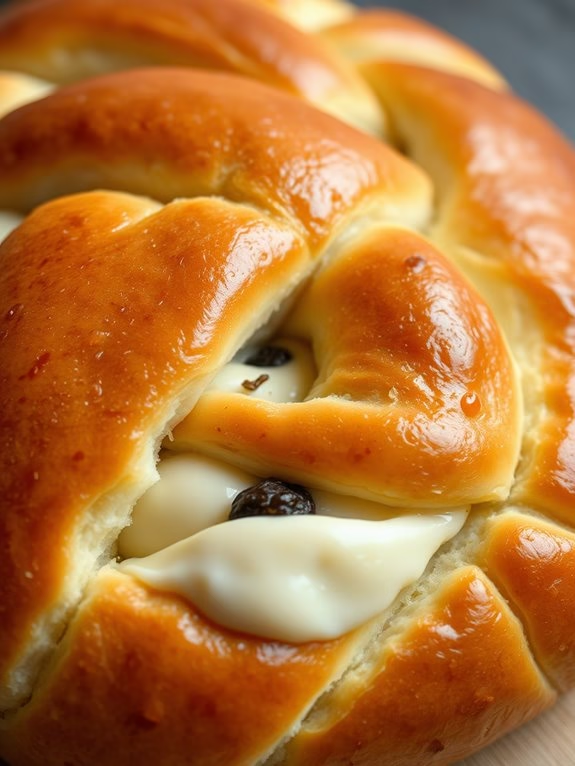
Romanian Pasca Bread is a traditional Easter cake that holds a special place in Romanian culture. This deliciously sweet bread is often baked during Easter festivities and features a rich, cheesy filling that’s both creamy and slightly tangy. The bread itself is soft, fluffy, and lightly sweetened, providing the perfect contrast to the savory filling. This delightful combination of flavors and textures makes Romanian Pasca Bread a must-try recipe for anyone looking to explore the rich culinary heritage of Romania.
The preparation of Romanian Pasca Bread involves creating a yeast-based dough that’s allowed to rise before being filled with a mixture of cream cheese, eggs, sugar, and a hint of vanilla. The dough is then shaped into a beautiful braided loaf, encasing the creamy filling, and baked until golden brown. This recipe serves 4-6 people, making it an ideal treat for a family gathering or Easter celebration. With its delightful aroma and enchanting taste, this bread is sure to be a centerpiece on any Easter table.
Ingredients:
For the Dough:
- 3 1/4 cups all-purpose flour
- 1/2 cup sugar
- 1 packet (2 1/4 tsp) active dry yeast
- 1/2 cup warm milk (110°F/45°C)
- 1/4 cup unsalted butter, melted
- 2 large eggs
- 1/4 teaspoon salt
- Zest of 1 lemon
For the Filling:
- 1 1/2 cups cream cheese, softened
- 1/2 cup sugar
- 2 large eggs
- 1 teaspoon vanilla extract
- 1/4 cup raisins (optional)
Cooking Instructions:
- Prepare the Dough:
- In a small bowl, dissolve the yeast in warm milk and allow it to sit for about 5 minutes, or until it becomes foamy.
- In a large mixing bowl, combine the flour, sugar, and salt. Add the yeast mixture, melted butter, eggs, and lemon zest. Mix the ingredients until a soft dough forms.
- Knead the dough on a floured surface for about 8-10 minutes, or until it becomes smooth and elastic. Place the dough in a greased bowl, cover it with a damp cloth, and let it rise in a warm place for 1-1.5 hours, or until it doubles in size.
- Prepare the Filling:
- In a medium bowl, mix together the cream cheese, sugar, eggs, and vanilla extract until smooth and creamy. If using, fold in the raisins.
- Assemble the Bread:
- Preheat your oven to 350°F (175°C). Grease a round baking pan.
- Punch down the risen dough and divide it into two portions — one slightly larger than the other.
- Roll out the larger portion into a circle to fit the bottom and sides of the baking pan. Press it into the prepared pan.
- Pour the cheese filling over the dough in the pan.
- Roll the remaining dough portion into a circle and cut it into strips. Braid the strips and place them in a crisscross pattern over the filling, or simply create a border around the edge.
- Let the assembled bread rest for another 15-20 minutes.
- Bake the Bread:
- Brush the top of the bread with a beaten egg for a shiny finish.
- Bake in the preheated oven for 40-45 minutes, or until the bread is golden brown and the filling is set.
- Allow the bread to cool slightly before removing it from the pan and serving.
Extra Tips:
For best results, make sure all your ingredients are at room temperature before beginning. This will help the dough rise more efficiently. If you prefer a sweeter filling, feel free to increase the amount of sugar in the cheese mixture. Additionally, soaking the raisins in a bit of rum or warm water before adding them to the filling can enhance their flavor and prevent them from drying out during baking. Enjoy your Romanian Pasca Bread warm or at room temperature for a delightful Easter treat!
Dutch Paasstol

Dutch Paasstol is a traditional Easter bread that’s rich, fruity, and filled with flavor, making it a festive addition to any Easter celebration. This delightful bread is similar to a fruitcake but is much lighter and often filled with a sweet almond paste. It’s typically enjoyed sliced with a generous layer of butter, making it a perfect accompaniment to Easter brunch or afternoon tea. The bread’s unique flavor comes from a combination of dried fruits, almonds, and warming spices, all wrapped in a deliciously soft dough.
Originating from the Netherlands, the Paasstol is a staple during the Easter season. Its name comes from “Pasen,” meaning Easter, and “stol,” a type of bread. This bread is deeply rooted in Dutch tradition and is similar to the Kerststol, which is enjoyed at Christmas. The preparation of Dutch Paasstol involves marinating fruits, preparing a flavorful dough, and incorporating a rich almond paste. Baking this bread fills your home with a warm, welcoming aroma that’s sure to delight everyone around the table.
Ingredients (Serves 4-6):
- 500g all-purpose flour
- 7g instant yeast
- 100g granulated sugar
- 1 teaspoon salt
- 1 teaspoon ground cinnamon
- 200ml warm milk
- 1 large egg
- 100g unsalted butter, softened
- 200g mixed dried fruits (e.g., raisins, currants, candied peel)
- 50g chopped almonds
- 200g almond paste
- Zest of 1 lemon
- 1 tablespoon rum (optional)
- Powdered sugar for dusting
Cooking Instructions:
- Prepare the Fruit Mixture: In a small bowl, combine the mixed dried fruits, lemon zest, and rum (if using). Allow to soak for at least 30 minutes or overnight, so the fruits absorb the flavors and become plump.
- Make the Dough: In a large mixing bowl, combine the flour, yeast, sugar, salt, and cinnamon. Create a well in the center and add the warm milk, egg, and softened butter. Mix until a soft dough forms. Knead the dough on a floured surface for about 10 minutes until it’s smooth and elastic.
- Incorporate Fruits and Nuts: Gently knead the soaked fruits and chopped almonds into the dough until evenly distributed. Be careful not to over-knead, as this can crush the fruits.
- First Rise: Place the dough in a lightly greased bowl, cover it with a cloth, and let it rise in a warm environment for about 1 to 1.5 hours, or until doubled in size.
- Shape the Bread: Roll the dough out into an oval shape on a floured surface. Place the almond paste down the center of the oval. Fold the dough over the almond paste, sealing the edges to enclose it.
- Second Rise: Transfer the shaped dough onto a baking sheet lined with parchment paper. Cover and let rise for another 30 minutes.
- Bake the Bread: Preheat your oven to 180°C (350°F). Bake the Paasstol for 30-35 minutes, or until golden brown and hollow-sounding when tapped on the bottom.
- Cool and Serve: Allow the bread to cool on a wire rack. Once cooled, dust with powdered sugar before serving.
Extra Tips:
To guarantee the best texture in your Dutch Paasstol, make sure all ingredients are at room temperature before you start baking. When shaping the bread, be gentle to maintain the dough’s lightness and avoid deflating the air bubbles that formed during rising.
If you prefer a more pronounced almond flavor, you can add a few drops of almond extract to the almond paste before using it. Additionally, for a more festive look, sprinkle some slivered almonds on top of the bread before baking. Enjoy this bread fresh, as the flavors and texture are best within a day or two of baking.
Cypriot Flaounes Cake
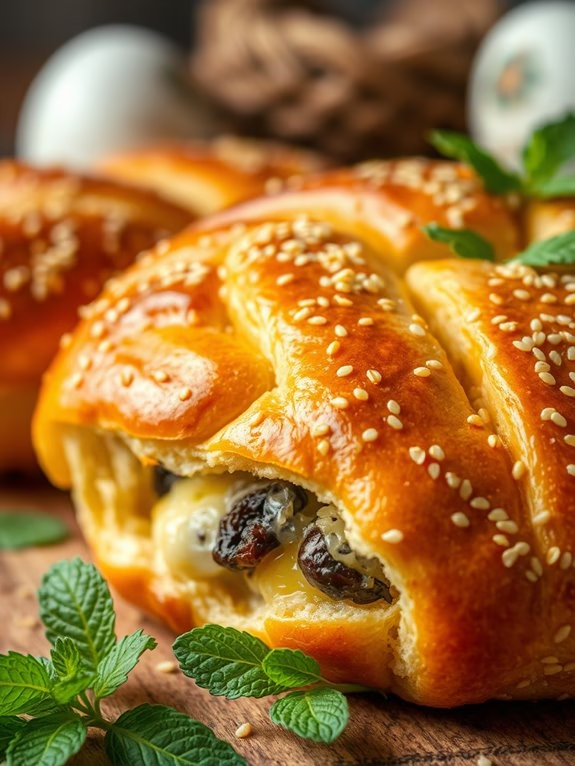
Cypriot Flaounes Cake is a traditional Easter dish that hails from Cyprus. This savory pastry is typically made during the Easter season and is cherished for its unique combination of flavors and textures. Flaounes are filled with a delightful mixture of cheese, raisins, and mint, all nestled inside a crisp, golden pastry. The preparation process is a labor of love, but the resulting cakes are well worth the effort. They can be enjoyed warm or at room temperature, making them a versatile addition to any Easter celebration.
While flaounes are traditionally made in large batches for sharing with family and friends, this recipe is designed to serve 4-6 people, perfect for a more intimate gathering. The key to a great flaounes cake is in the balance of ingredients, so be certain to follow the measurements closely to guarantee the perfect taste and texture. The use of both dry and fresh mint gives the filling a revitalizing quality, while the mixture of cheeses adds depth and richness. The dough, enriched with mahleb and mastic, offers an aromatic and slightly sweet contrast to the savory filling.
Ingredients (Serves 4-6):
- 500g all-purpose flour
- 125g unsalted butter, softened
- 1 packet (7g) instant yeast
- 1 teaspoon sugar
- 1 teaspoon salt
- 2 teaspoons mahleb, ground
- 1/2 teaspoon mastic, ground
- 200ml warm milk
- 3 eggs, beaten
- 250g halloumi cheese, grated
- 250g anari cheese, grated (or ricotta as a substitute)
- 100g raisins
- 1 tablespoon dried mint
- 1/4 cup fresh mint, chopped
- 1 egg, beaten (for brushing)
- Sesame seeds for topping
Cooking Instructions:
- Prepare the Dough: In a large bowl, mix the flour, mahleb, mastic, sugar, and salt. Add the softened butter and rub it into the flour mixture until it resembles breadcrumbs. Dissolve the yeast in the warm milk and pour into the flour mixture. Add the beaten eggs and mix until a soft dough forms. Knead the dough for about 10 minutes until smooth and elastic. Cover the bowl with a damp cloth and let it rise in a warm place for about 1 hour, or until doubled in size.
- Prepare the Filling: While the dough is rising, combine the halloumi and anari cheeses, raisins, dried mint, and fresh mint in a separate bowl. Mix well to guarantee the ingredients are evenly distributed.
- Assemble the Flaounes: Preheat your oven to 180°C (350°F). Once the dough has risen, punch it down and divide it into equal pieces, about the size of a golf ball. Roll each piece into a thin circle on a floured surface. Place a generous spoonful of the filling in the center of each circle.
- Shape and Seal: To shape the flaounes, fold the edges of the dough over the filling, creating a triangular or square shape that leaves part of the filling exposed. Press the edges to seal them. Place the flaounes on a baking tray lined with parchment paper.
- Final Touches and Baking: Brush each flaouna with the beaten egg and sprinkle with sesame seeds. Bake in the preheated oven for about 25-30 minutes, or until the pastry is golden brown and the filling is bubbly.
Extra Tips:
When making Cypriot Flaounes Cake, it’s essential to let the dough rise properly, as this step guarantees a light and fluffy pastry. If the dough is too sticky, add a bit more flour during kneading until it reaches the desired consistency.
For a more authentic flavor, try to source mahleb and mastic from a specialty store. If you prefer a sweeter touch, consider adding a touch more sugar to the filling or the dough.
Finally, flaounes can be made in advance and frozen; just reheat them in the oven before serving.

